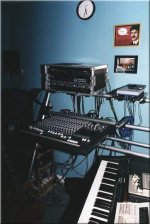
Gregory did his first synthesizer programming during the recording of the English Settlement album, for which the band bought their Prophet-5. The sounds on that album resulted from collaborations between Gregory, Partridge, and producer Hugh Padgham, but he characterizes the process as having been "by the seat of our pants, really."
On Skylarking, Rundgren played a large part in the sound design as well as the drum machine programming, working with his own Fairlight ("his rather elderly Fairlight, it must be said," Gregory interjects), DX7, Emulator, and pre-MIDI LinnDrum. "The only instruments we took over [to America] were about eight guitars," Gregory says. "In fact, to be honest with you, the only keyboards that we actually own are a small synthesizer of mine, a Roland JX-3P. I bought the thing ages ago. We sold our Prophet because we kept going wrong and we needed the money."
"Todd bought a Prophet-10 especially for this album," he adds. "We went into this shop on 48th Street, and Todd saw this thing going cheap, and said, `All right, we'll have that.' So there we were, wheeling it through the streets of New York in a flight case. It was quite funny to watch."
As it turns out, Rundgren conceived and executed the keyboard parts in "That's Really Super, Supergirl" at the band's request. "We really didn't know what to do with it," Gregory says. "It was just a `B' side, and he could obviously see possibilities in it. One afternoon, we just left him to it." It's typical that Rundgren took no credit for the work, given his attitude that any task involved in producing is all in a day's work.
"I was talking to him about the Tubes album that he produced, Remote Control," Gregory recalls. "There are a couple of pieces of music on that album that are unmistakably Todd. No other musician could possibly have come up with those particular chords, that particular melody, or that particular arrangement. I said to him, `You're not credited with writing half of this stuff, Todd. Why is that?' He just said, `Oh, it's all right. I got a production credit and I got paid.' He's quite modest in that respect. But at the same time," Gregory adds, "Todd has his ego, no doubt about that."
Another area of Rundgren's impact is the string and brass arrangements, of which he did all but one. "He did most of those arrangements in one evening" Gregory exclaims. "He's a real computer nut, and he's got this add-on keyboard for his Macintosh computer that will print the music out as you play. Then you can go back and update things without the hassle of having to write it all out manually. He'd go away and, literally, come back the next morning with a complete string chart, like the one in "Sacrificial Bonfire." That's a ridiculous part, you know? I've still got the computer printouts here in my home."
